| Lesson 9 | Overview of the steps for creating and using an Access database |
| Objective | List the steps involved in creating and using an Access database |
Overview of the Steps for Creating and Using an Access Database
The general steps for creating a database are described in the following series of images.
However, you may find that when you are creating a database you do not complete these steps in exactly this order.
Steps in building a Database
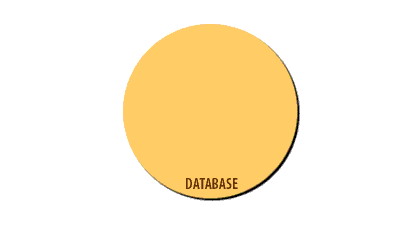
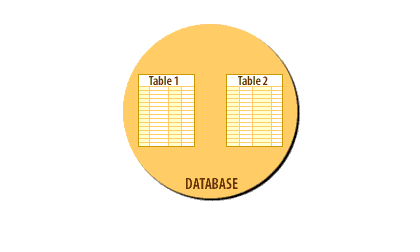
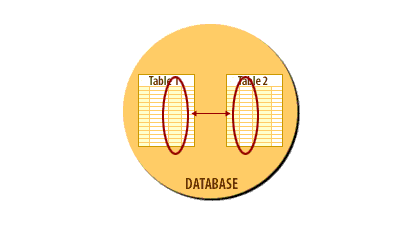
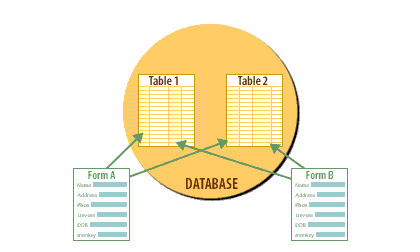
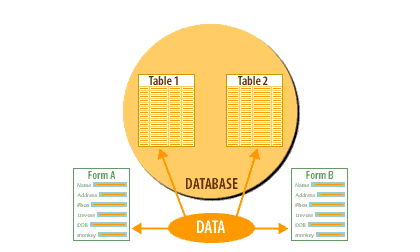
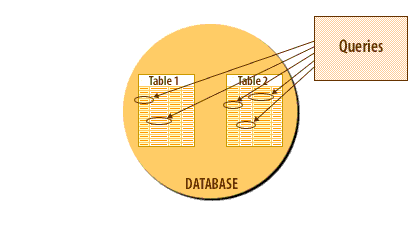
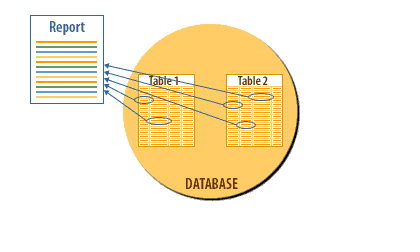
More complex reports are useful for analysis- they can group and summarize data.
- Open a new database: You must save a new database file before you can begin creating database objects.
- Design and create tables: Design tables to hold your data.
- Tell Access how your tables are related: If you have multiple tables with related data in your database you have to tell Access how the tables are related (This is done with the repetition of a field in two tables).
- Create forms to make data entry easier. Forms can provide a more familiar environment to enter data because they're more like the paper forms you may be used to.
- Enter you data: You can enter data directly into tables, or use one or more forms to enter data into the underlying tables.
- Create queries to give you the information you need: Once you have data in your database you may want to look at subset of the complete database.
- Create reports to display data and summarized data on paper.
Steps For Creating and Using Access Database
Let us practice the order of the database creation steps with this exercise.
Review what you have learned in this module and try your hand at a database design. Steps For Creating Access Database.
Review what you have learned in this module and try your hand at a database design. Steps For Creating Access Database.
- Open a new database.
- Design and create tables.
- Tell Access how your tables are related.
- Create forms to make data entry easier
- Enter your data.
- Create queries to give you the information you need.
- Create reports to display data and summarized data on paper.
Planning for Database Objects
To create database objects, such as tables, forms, and reports, you first complete a series of design tasks.
The better your design is, the better your application will be. The more you think through your design, the faster and more successfully you can complete any system. The design process is not some necessary evil, nor is its intent to produce voluminous amounts of documentation.
The sole intent of designing an object is to produce a clear-cut path to follow as you implement it.
When you create database tables, you should assign each table a primary key. This key is a way to make sure that the table records contain only one unique value; for example, you may have several contacts named Michael Heinrich, and you may even have more than one Michael Heinrich (for example, father and son) living at the same address. So, in a case like this, you have to decide how you can create a record in the Customers database that will let you identify each Michael Heinrich separately. Uniquely identifying each record in a table is precisely what a primary key fi eld does. For example, using Collectible Mini Cars as an example, the CustomerID fi eld (a unique number that you assign to each customer placing an order) is the primary key in tblCustomers each record in the table has a different CustomerID number. (No two records have the samenumber.)
When you create database tables, you should assign each table a primary key. This key is a way to make sure that the table records contain only one unique value; for example, you may have several contacts named Michael Heinrich, and you may even have more than one Michael Heinrich (for example, father and son) living at the same address. So, in a case like this, you have to decide how you can create a record in the Customers database that will let you identify each Michael Heinrich separately. Uniquely identifying each record in a table is precisely what a primary key fi eld does. For example, using Collectible Mini Cars as an example, the CustomerID fi eld (a unique number that you assign to each customer placing an order) is the primary key in tblCustomers each record in the table has a different CustomerID number. (No two records have the samenumber.)